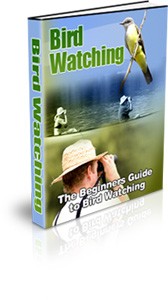 License Type: Private Label Rights
License Type: Private Label Rights  File Size: 410 KB
File Size: 410 KB File Type: ZIP
File Type: ZIP
 SKU: 1245
SKU: 1245  Shipping: Online Download
Shipping: Online Download
Ebook Sample Content Preview:
If you really have the desire to bird watch there is a certain way to go about it for beginners. Remember, as mentioned before, anyone can take up the sport of birding, it just takes time to get acquainted with the ins and outs. The first step is to acquire a pair of binoculars, adjust them to your preference, and try them out a few times before you actually need them. The binoculars are so that you can get a better view of the bird without having to get so close that you might scare it off. Also, not all binoculars are created equal; there are different types that offer different functions. It might even be helpful to ask a salesman to explain the differences between different models.
It's good to get in the habit of locating birds with your eye first, without the aid of the binoculars. This is important because you have a greater range of vision with the naked eye than you do with binoculars initially. When focusing primarily through binoculars you might miss the chance of locating the bird due to the smaller field of view. Binoculars have the primary objective of narrowing in on an object for better definition. It's wise to wait on using the binoculars until you have already found your target.
Now that you have the primary equipment needed, it's time to go look for birds. How do you find the birds? It's a good idea to learn the habitats of birds so you know what to look for. It's important to note that each species of bird have their own habitat preference, birds are much like other animals that in each breed, or species is different. Once you know what to look for and where to look, the task of finding birds will become much easier. It's also helpful to listen as well; you may often hear the bird before you see it.
So you've found your first specimen, what exactly are you looking for beyond identifying that it's a bird? Although it may be difficult to decipher, color is definitely something to look for when birding. If you have the opportunity to observe color, you are very lucky because normally it's hard to view colors correctly, even for the most seasoned birder. The difficulty in observing the correct color of a species is due to many factors such as lighting as well as shadows which make it hard to be accurate.
Size is another factor to consider when birding. Size can help you rule out certain other species quite quickly. For example it is quite obvious that a small bird such as a Mountain Blue bird wouldn't be put in the same category as a large bird such as a Heron or Hawk. Size can also be deceiving though. You must take into consideration the conditions that you are observing the bird in. If the bird is flying overhead, the size of the bird may appear much larger or smaller than it actually is. If you find yourself in this situation, it is sometimes helpful to compare the size of the bird to something equal in distance that you are familiar with such as a tree.
Shape and profile is also something to look for when birding. It's highly suggested to invest in some sort of bird guide. A bird guide is easy to take into the field with you and will help you to identify birds. Once you become familiar with the certain characteristics of birds through the guide, you will be able to rule out certain types on shape and profile alone. A bird guide is also helpful when you are out in the field and spot a bird you are not familiar with. The guide provides information as well as pictures to help guide you through and is helpful to beginners as well as those familiar in the sport of birding. Once you become more comfortable you can graduate to the National Geographic Field Guide to the Birds of North America 3rd edition.








